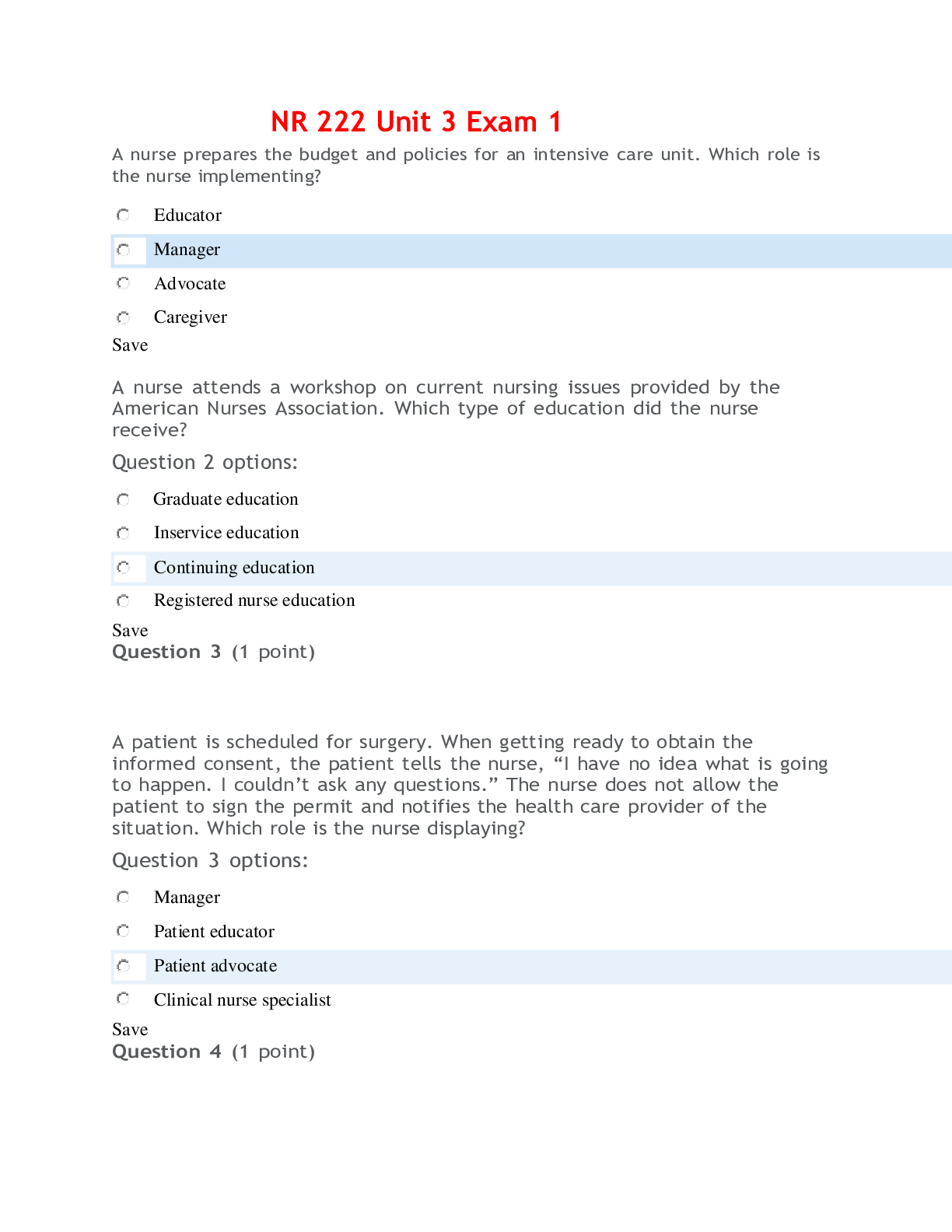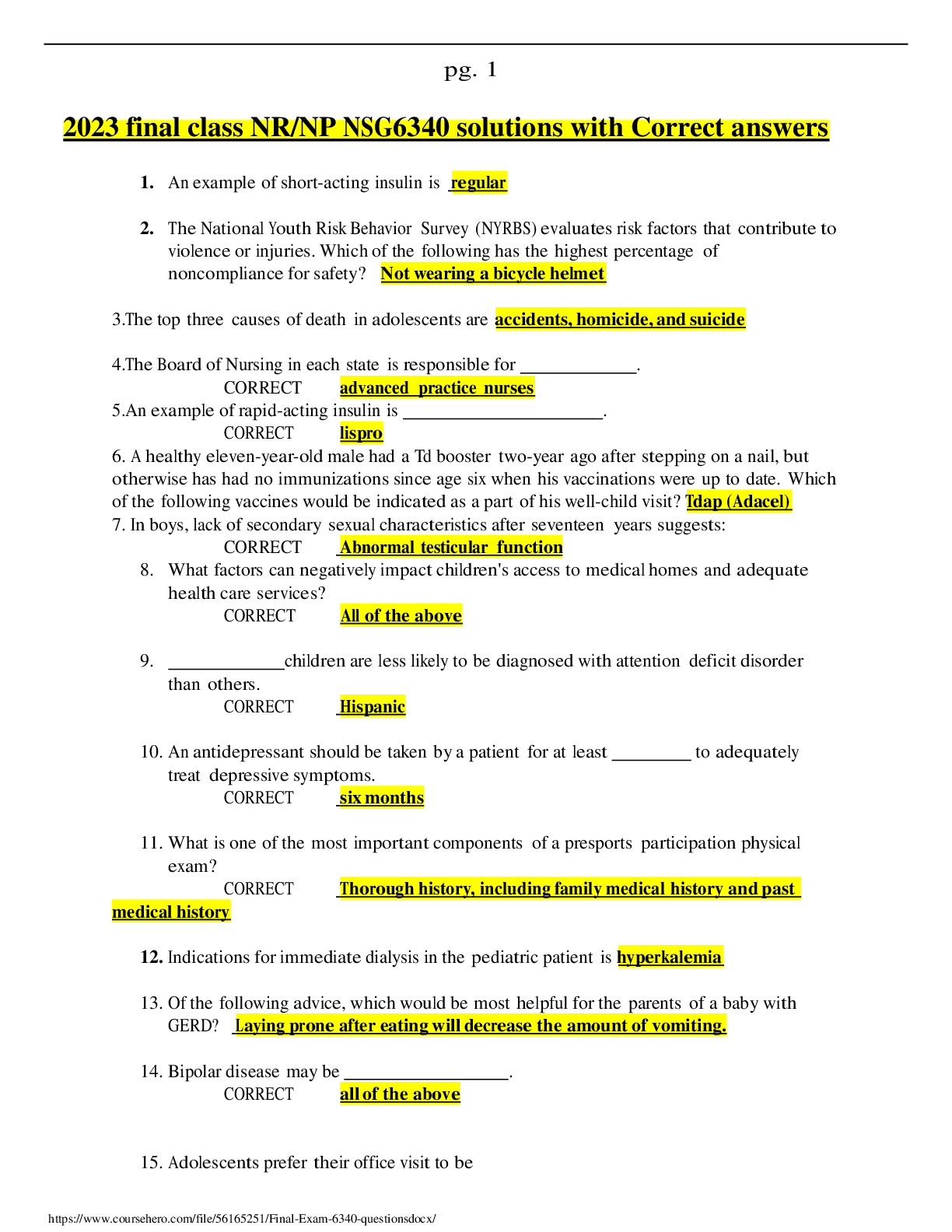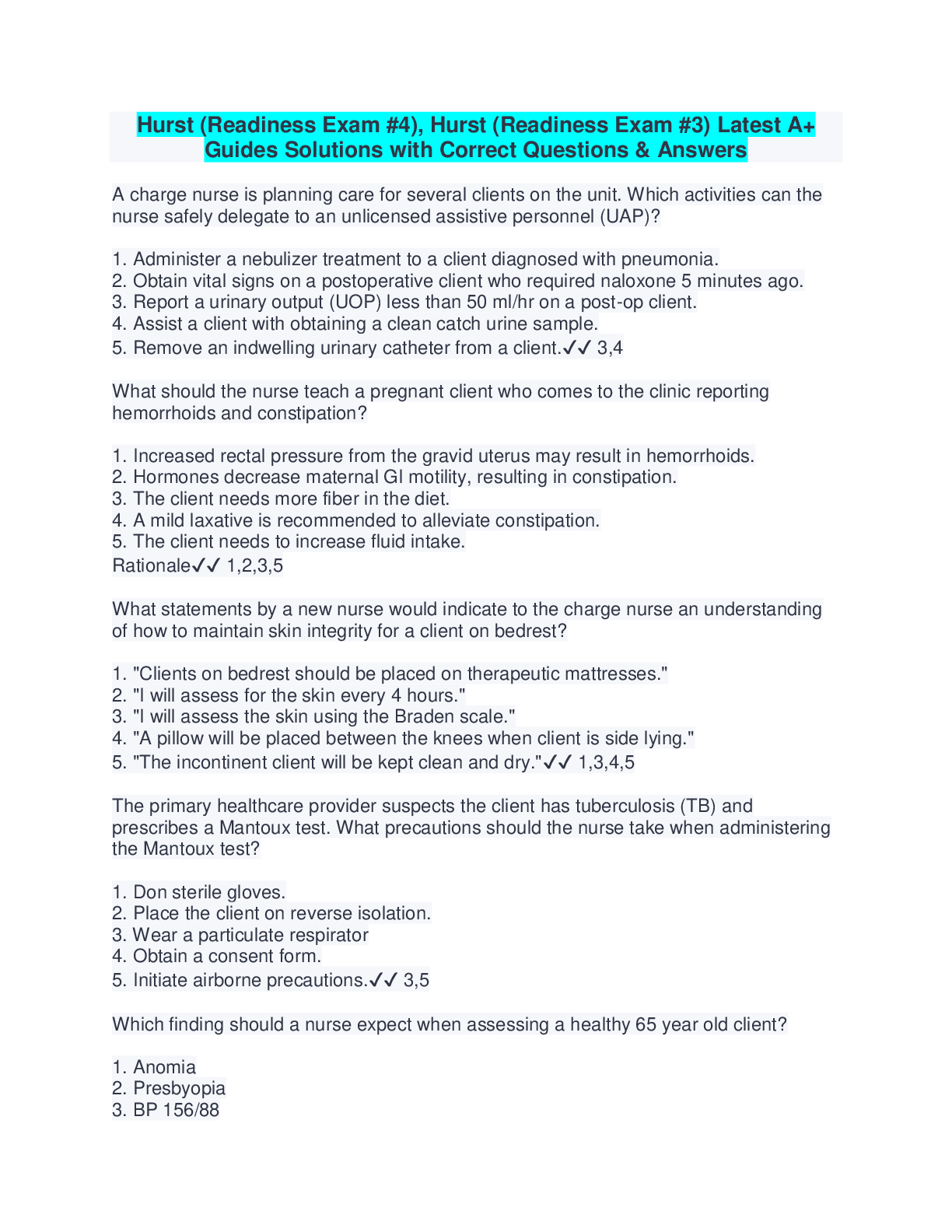SOCS 185 SOCIOLOGY FINAL COMPLETE SOLUTIONS WITH CORRECT ANSWERS 2021
Document Content and Description Below
SOCS 185 SOCIOLOGY FINAL COMPLETE SOLUTIONS WITH CORRECT ANSWERS 2021 Question 1 0 / 5 pts (TCO 8) Why is the term called the crude birth rate? If you’ve ever attended a birth, you unders... tand that it can get kind of crude. The rate is crude because males and females, not in their childbearing years, are part of the equation. To compare societies have differing proportions of females in their childbearing years. The crude birth rate is precise, but difficult to calculate. It is calculated using the average annual number of births and deaths. Chapter 15 Question 2 5 / 5 pts (TCO 8) According to Emile Durkheim, while traditional, rural societies were built on _____, modern urban societies are held together by _____. likeness; difference difference; likeness money; morals trust; duct tape choice; conformity Chapter 15 Question 3 5 / 5 pts (TCO 3) Max Weber’s thesis on the Protestant ethic and the spirit of capitalism highlighted the importance of which of the following in the process of social change? Invention Ideas Social conflict Cultural diffusion Discovery Chapter 16 Question 4 0 / 5 pts (TCO 3) Durkheim’s _____ is similar to Tennies’ _____. mechanical solidarity; Gesellschaft organic solidarity; Gesellschaft Countach; Boxter social solidarity; Gemeinschaft organic solidarity; Gemeinschaft Chapter 15 Question 5 5 / 5 pts (TCO 8) Which English economist and clergyman warned that rapid population increase would lead to social chaos? Fredrick Engles Thomas Robert Malthus Les Ismore Paul Ehrlich Ralph Nader Chapter 15 Question 6 5 / 5 pts (TCO 3) David Riesman believes that pre-industrial societies promote _____, while modern societies promote _____. collective ego; social ego other-directedness; traditional-directedness traditional-directedness; other-directedness social character; collective character family values; Manson family values Chapter 16 Question 7 5 / 5 pts (TCO 3) Which term is used by sociologists to refer to organized collective activities that encourages or discourages social change? Social movements Social groups Power movements Pressure groups Lobbying group Chapter 16 Question 8 5 / 5 pts (TCO 8) Which term refers to material culture changing faster than nonmaterial culture? Culture shock Culture lag Cultural relativity Cultural integration Cultural relativism Chapter 16 Question 9 5 / 5 pts (TCO 3) David Riesman described other-directed social character as which of the following? Openness to the latest trends and fashions Rigid conformity to established ways of life Being highly individualistic Helping others before helping yourself Unique Chapter 16 Question 10 5 / 5 pts (TCO 8) Of the various types of social movements, which is least threatening to the status quo? Alternative social movements Redemptive social movements Reformative social movements Revolutionary social movements Reactionary social movements Chapter 16 Question 11 40 / 40 pts (TCOs 1, 2, 3, and 4) Explain the steps in the process of carrying out sociological investigation. What specific questions must be answered as a researcher moves through their investigation? Your Answer: To carry out a Sociological investigation requires being able to look at the world using the sociological perspective, as well as to remain curious and ask questions. To look at the world in a sociological perspective one must identify unusual patterns of behavior that may call for further study. In order to carry out a social investigation nine steps are needed to carry out and question every step to reveal why your experiment to place and time when it did. The nine steps are: identify an area of interest, exploration, problem identification, theoretical framework, building a hypothesis and research questions, research design to validate or continue on with a survey, collect data, test your hypothesis, and write down what your reported findings were. Chapter 1 Answer should include: What is your topic? What have others already learned? What, exactly, are your questions? What will you need to carry out research? Are there ethical concerns? What method will you use? How will you record the data? What do the data tell you? What are your conclusions? How can you share what you’ve learned? Question 12 40 / 40 pts (TCOs 3 and 8) You have been asked by a committee of student success coaches to investigate why the rate at which freshman students post to their course threaded discussions is lower than the rate for other groups of students. Explain how the structural-functionalist perspective would analyze and explain the low posting rate. (In other words, consider the contributing factors that the structural-functionalist perspective would focus on in trying to explain the reasons for the low rate of students posting to their threads.) Then discuss a solution that a functionalist might use to encourage freshman students to post. Your Answer: I believe a lower rate of postings for a discussion for a freshman is varied on the individual however, there may be a few reasons that explain the majority. The first is the Freshman does not understand the value of their grade and may have a sense of self-entitlement since that have payed for there class. Another theory is that being a freshman and new to the school environment the freshman may have not adapted to a routine to post in a timely manner. My last theory is to conclude that a Freshman may also feel that they are just here to go by the numbers as in to get there grade and get out. Chapter 1 covers the basic elements of the core sociological theories. In addressing the first part of this question, students will need to demonstrate that they understand the basic ideas and concepts of functional theory. In addressing the second part of this question, students will need to demonstrate that they can offer a solution to the problem based on functionalist theory. Question 13 40 / 40 pts (TCOs 6 and 7) Contrast mass-society theory with class-society theory and give a criticism of each. Your Answer: mass-society argues that social movements attract socially isolated people who join a movement in order to gain a sense of belonging, identity, and purpose -from this point of view, social movements have a personal as well as a political agenda A great example is a 49ers Colin Kaepernick who sits during the national anthem due to his belief that colored people are still oppressed in the US. This has caused an uproar in the NFL as die hard fans of the 49ers may now feel that have to take a side if they should stand by there team and its decision to keep Colin Kapernick as a player. class society establishes that elites are still with us not as the nobles of an earlier era but in the form of capitalist millionaires; while agreeing that modern societies have expanded to a mass scale, this approach views the heart of modernization as an expanding capitalist economy marked by inequality. Rich US families such as the Walton family being the owners of the one stop shop we all know is Wal-Mart hold a high influence in what Americans buy. I feel Americans will forever and will always use Wal-Mart as there go to store as prices are always on the low and you can almost find any thing you need. Chapter 16. The answer should include a discussion of the differences between class-society and mass-society theories and their criticisms. Conventional goals with socially accepted means. Question 14 40 / 40 pts (TCOs 3, 4, and 6) Identify and describe the three leadership styles. Provide examples of these styles in society. Your Answer: Authoritarian leadership is what that I commonly see in my line of work. It can be referred to the "do as I say, and not as I do" quote. Where the authoritarian's figure is upheld without question. This type of leadership is ideal for quick decision making and enforcing tasks throughout the day. This can be faulted by human emotions to take hold and may inspire an uprising throughout the ranks. Morale may be lowered during the objective and could potentially back fire if pushed to hard with little reward. A democratic leadership allows for questioning and for others to decide together on a given objective. This may be a slower decision process, but will be a more thought out plan and the ability to feel like to have a choice or decision in the matter will gain a higher morale as an objective can be seen as working together to make the objective accomplished. The final leadership style is the Laissez-faire leadership. This incorporates no leadership and others do as they will. Rules and guidelines will not be enforced and the reputation and culture of a given group may be at risk. With no leadership the objective could lose sight is least effective in decision making. Chapter 5 Question 15 40 / 40 pts (TCOs 5, 6, and 8) Define and give examples of ascribed status, achieved status, master status, role conflic,t and role strain. Your Answer: Ascribed status is a situation in a social system that is beyond an individual's control. People are born into it this can be because of: sex, race, county of origin. Achieved status: Is a position that is developed on the basis of difference, it is earned or chosen which reflects a person's skills, talents and efforts. Master status: This is an important position that a person occupy.it influences ones behavior and social identity, it is the principal of a social identity, like how a profession affects other roles. Examples can include family, friends, where they live, gender, age. Role conflict: This is when the roles are both associated with the same status, this happens when people are confronted with incompatible role expectations in the statuses they occupy. A great example is a customer conflicting with a mechanic about what needs to be fixed on a vehicle. Role strain: This happens when an individual experiences incompatible behavior, expectations, or when obligations are associated with a single social role. When status compete with each other. In the Marine Corps we call it Semper Gumby meaning to always be flexible. One day you’re a field radio operator and in a matter of an hour you are a motor transport mechanic changing the oil on a hmmwv. Chapter 4. Ascribed status is a social position you are born with or into (being male), achieved status is a social position you earn through your own merit (college student), master status is the one status that you occupy that most clearly defines who you are (usually your occupation), role conflict is the incompatibility of expectations from different roles from two statuses that you occupy at the same time (boss and family both need you at the same time), role strain is the incompatibility of expectations from different roles from a single status that you occupy (daughter’s science fair is at same time as son’s Math Olympics). [Show More]
Last updated: 2 years ago
Preview 1 out of 8 pages

Buy this document to get the full access instantly
Instant Download Access after purchase
Buy NowInstant download
We Accept:

Reviews( 0 )
$8.50
Can't find what you want? Try our AI powered Search
Document information
Connected school, study & course
About the document
Uploaded On
Jan 08, 2021
Number of pages
8
Written in
Additional information
This document has been written for:
Uploaded
Jan 08, 2021
Downloads
0
Views
87












.png)





